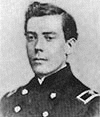 Open main menu
Open main menu
 Open main menu
Open main menu

W. J. Palmer
(1836 - 1909)
Home State: Pennsylvania
Command Billet: Commanding Regiment
Branch of Service: Cavalry
Before Antietam
Palmer had begun working in the engineering corps of the Hempfield Railroad at age 17 in 1853. He went to England and France for the company, learning foreign railroading techniques. He was later private secretary to John E. Thompson, President of the Pennsylvania Railroad.
In 1862 he raised the Anderson Troop - a company of elite cavalry. After training, the Anderson Troop were assigned to General Buell's headquarters at Louisville, KY.
Buell thought enough of Palmer and his Troop to recommend to the War Department that he be returned to Pennsylvania to recruit the unit up to a battalion. He went to Philadelphia on 21 July 1862 for that purpose, and was successful in raising a whole regiment, who began their training at the Carlisle Cavalry Barracks, PA.
On the Campaign
At the outset of what became the Maryland Campaign, about 250 men of this Regiment were ordered to Greencastle, PA to help defend the borders of the State, and they saw skirmishing action there. As the Confederates were arriving at South Mountain, a detachment of these were ordered to the vicinity of Hagerstown.
During the Battle of Antietam the detachment were scouts and rounded up stragglers. Palmer was captured while within Confederate lines in civilian clothes while gathering information for General McClellan.
The rest of the War
The Confederates did not believe Palmer's story that he was an innocent civilian, and he was imprisoned at Castle Thunder, in Richmond, VA. He was later exchanged for a political prisoner held in the North. Palmer rejoined his Regiment in in February 1863, and served with it through the campaigns of the Western Theater to the end of the War.
He was awarded the Medal of Honor for action against the enemy at Red Hill, Alabama in January 1865.
After the War
He was a managing director of the Kansas Pacific Railroad, in charge of extending the line to Denver, Colorado. In 1870 he founded the Denver & Rio Grande Railroad. He had planned that the D&RG would be a north-south line, with adjacent development. He laid out the city of Colorado Springs, and built the first house there in 1871.
After a legal fight with the Sante Fe railroad over rights of way, he was defeated in the US Supreme Court in 1880, and resigned from the railroad and retired.
He had done very well in the railroad business, and gave gifts of money, parks, and lands to Colorado Springs. He died at his home in 1909 after his condition deteriorated following a fall from a horse, which had paralyzed him in 1906.
More on the Web
The source of most of the material and the photo used here was a beautifully presented Biography at the SW Civil War site of Tim Harrison, now defunct (2009). His source was John S. Fisher, A Builder of the West - The Life of General William Jackson Palmer. The fine Pennsylvania in the Civil War site is also an excellent resource on Col Palmer and his units.
Birth
9/17/1836; Kent County, DE
Death
3/13/1909; Colorado Springs, Colorado